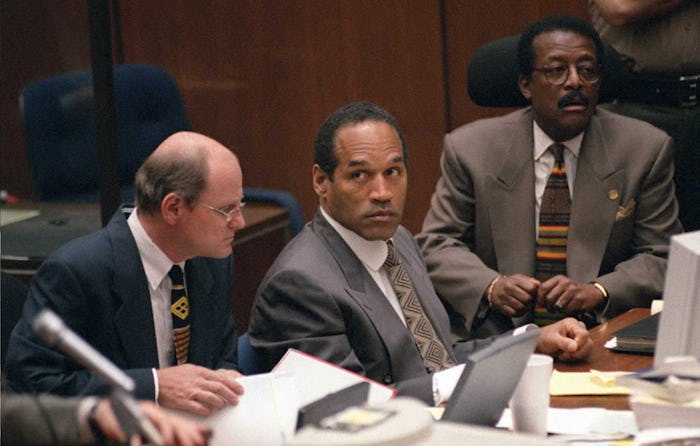News

Evidence From O.J. Simpson's Trial That Made Him Look Innocent, As Argued By The Defense
O.J. Simpson's murder trial is back in the news. The People v. O.J. Simpson: American Crime Story is set to premiere Tuesday at 10 p.m. ET on FX, reawakening public interest in what was once called the "Trial of the Century." The evidence for O.J. Simpson's innocence in the Nicole Brown Simpson murder is still controversial, even though the former NFL player's defense team ultimately won the case, and now, viewers are getting a second look.
In June 1994, Simpson's ex-wife, Nicole Brown Simpson, and friend Ronald L. Goldman were found dead of multiple stab wounds, according to police reports at the time. Though Judge Kathleen Kennedy-Powell initially said that prosecutors did not have "proof beyond a reasonable doubt" that Simpson himself was guilty of the murders, a hearing led her to conclude that he could still reasonably be considered a suspect. After the charges were made public, Simpson wrote a suicide letter and led police on a slow speed chase before surrendering. He pleaded not guilty, surrounding himself with some of the most powerful attorneys in the country (including Johnnie Cochran and Rob Kardashian). The criminal trial began in January 1995 and didn't end until the jury found Simpson not guilty in October of the same year.
Though the verdict was delivered 10 years ago, plenty of people who followed the original case still debate to this day who may have actually committed the murders. Here are three critical pieces of evidence the defense team used to establish Simpson's innocence, that Simpson's supporters often point to in their arguments.
The Glove
A bloody glove reportedly discovered at O.J. Simpson's home may be the most famous piece of evidence from the trial, according to a 2014 article in the Los Angeles Times. In 1996, the glove's matching twin was found at the scene of the crime, leading prosecutors to argue that Simpson had allegedly dropped it by accident. In contrast, the defense said that they believed one glove was planted at Simpson's house.
When Simpson was asked to try on the glove in the courtroom, however, it didn't slide on easily. The prosecution argued that the blood in which it had been covered could have shrunk the glove itself, adding that Simpson was also allegedly wearing a rubber glove under the leather one. Defense attorney Johnny Cochran famously capitalized on the controversy, coining the phrase, "If it doesn't fit, you must acquit" during his closing argument.
Methods Of DNA Evidence Collection

Blood found at the crime scene played a critical role in the Simpson case. Prosecutors claimed that Simpson allegedly cut his hand with a knife on the night of the two murders, according to USA Today, leaving blood tied to him in multiple lab tests. The defense argued that Simpson had actually injured his hand in his house, then re-injured it on a glass the next morning; They also claimed the cut reportedly wasn't nearly large enough to leave the amount of blood found at the scene. In a 2005 interview, Professor Gerald Uelmen of the Simpson defense team told PBS that it was essential to convince the jury that the DNA evidence had been collected improperly in order to keep Simpson out of jail for a crime he allegedly did not commit:
We realized going in that there were people who would say, "It's all over, the DNA tests are conclusive." And we knew that we weren't going to be able to keep the DNA evidence out. So our whole approach was, you can't trust DNA test results if you had incompetent people collecting the evidence and preserving the evidence. That the evidence is only as good as the people who collect it.
Accusations Of Planted Evidence
Cochran and his team challenged the police. Attorney Alan Dershowitz, who served on Simpson's defense team, revealed in an interview with PBS in 2005 that he still believed the blood-soaked sock was planted at the scene. He said that the pattern appeared to be consistent with pouring instead of crime-related splattering, and he acknowledged the presence of a chemical which seemed to indicate the blood had come from a tube:
There is absolutely no doubt that the sock that was soaked in blood was planted. Why? First of all, the blood had EDTA on it, a chemical that's an anticoagulant that is not found in the human body; it's only found in tubes. So we were able to prove that the police had poured blood from the test tubes onto the sock.
According to California's ABC 13, no members of law enforcement were ever "formally charged or investigated for planting evidence." But as Dershowitz said, the goal was only to make members of the jury doubt the prosecution's argument:
The theory of the defense was when you find a certain amount of lying and evidence planting on the other side, you can't trust any of the evidence, so the mountain wasn't enough to convict if a few of the hills and valleys were corrupted.
To this day, the impressive O.J. Simpson defense team tactics and theories continue to be studied and discussed. FX's The People v. O.J. Simpson: American Crime Story promises to take that one step further, by giving viewers a deeper look behind-the-scenes of one of the United States' most talked-about trials.